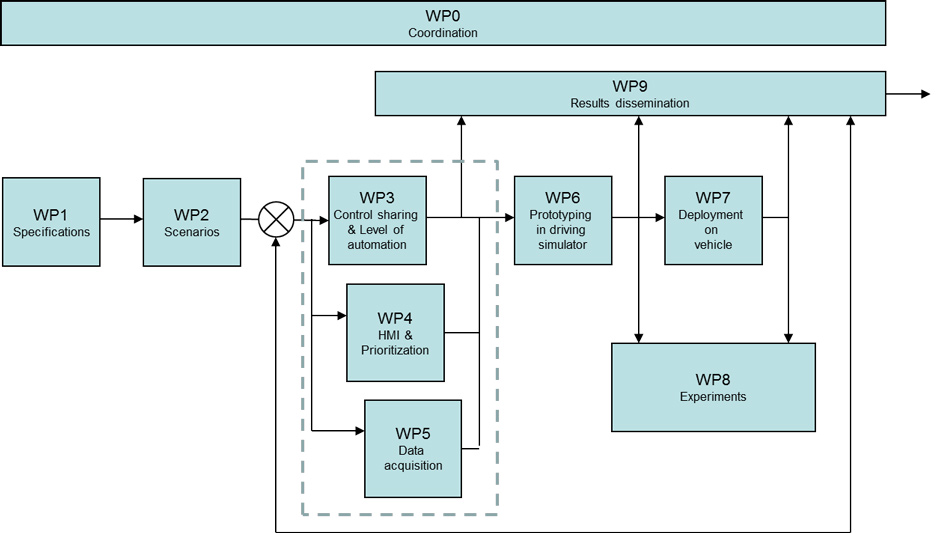Scientific and technical program, project organization
CoCoVeA is organized in 9 work packages.
WP1 (Specifications - Coordinator: LAMIH) aims to achieve a scientific and technical "state of the art" about embedded systems and methods currently used to validate their integration into the vehicles. This task aims at an homogenization and sharing of the knowledge between the partners. It will take the form of "workshops" dealing with technology or scientific aspects allowing exchanges between partners.
WP2 (Scenarios - Coordinator: PSA) aims to define the use cases that will be considered in the project. The chosen scenarios will allow to modify the level of automation and also to change the driving aids. These scenarios will be implemented and tested both on driving simulator and on real vehicle.
Three work packages will then be achieved in parallel: WP3, WP4 and WP5 which constitute the core of the innovation that will be produced by the project.
WP3 (Design of the control sharing and of the modulation of the level of automation - Coordinator: LAMIH) aims to define the criteria and methods used to manage the driver's activity through a real time tuning of the assistance systems actions. The goal is to provide to the driver the best support in order to improve his comfort, without compromising the safety. Scientific issues related to situation awareness, characterization of the automated functions, authority management, human-machine cooperation and sharing of degrees of freedom will be addressed.
WP4 (Design of the HMI and of the mechanisms used for information prioritization - Coordinator: VALEO) aims to determine measurements, criteria and methods that will be used to coordinate the operation of the in-board systems according to the capabilities of the driver regarding to the driving situation.
WP5 (Acquisition/construction of necessary information for WP3 and WP4 - Coordinator: INRIA) aims to develop the technical infrastructure necessary for the measurement of the data needed for the control sharing and for the information prioritization. It will be composed of a "measurement" section dealing with the driver himself (vigilance, attention, behavior, habits …) and of a "measures integration" section in order to characterize for example the adequacy between the driver's actions and the situation, to check the operating range of the support systems, to build a representation of the operational context …
WP6 (Prototyping and functional evaluation in driving simulator - Coordinator: LAMIH) aims to implement in the driving simulator software prototypes of solutions developed during WP3, WP4 and WP5. These work packages will allow to quickly deploy and test these solutions and also to validate global concepts developed in the framework of the project. The functional evaluation performed with the prototypes during WP8 will allow a quick feedback towards the three specification work packages (WP3, WP4 & WP5).

Structure of CoCoVeA project
WP7 (Deployment on vehicle - Coordinator: AKKA) aims at implementing the project through the realization of two driving demonstrators. The vehicles available within the consortium will be used to implement all or part of the systems previously validated in the simulator.
WP8 (Experiments towards a functional validation - Coordinator: UNICAEN) will supervise experiments on simulator and on real vehicle (test track). "Normal" driving situations will be used to validate the final system in real conditions on a panel of drivers.
WP9 (Dissemination of results - Coordinator: LAMIH) will take place throughout the project and will ensure the experience feedback to both partners but also to the entire scientific community.
Economic, technical and scientific impact
At the scientific and technical level, this research project addresses a very original issue whose resolution could pave the way for a wide variety of use cases where the security of the path is the central concern. This will include:
- The definition and the implementation of an architecture that allows the control of the level of automation and the control sharing for the automated driving;
- The definition and the implementation of a multi-system architecture dedicated to the control and the filtering of various automatons or information systems;
- The definition of criteria and measures on the driver, on the vehicle, and on the traffic in order to feed algorithms for online modification of the level of automation of the global system and for information filtering;
- The implementation of demonstrators on both simulator and real vehicle of the scientific and technological choices;
- The experimental evaluation of the implemented solutions on the demonstrators (both simulator and vehicles on test track);
- The formalization of results through recommendation reports capitalizing on knowledge gathered during the project.
Sur le plan sociétal, outre le gain en sécurité qui peut être attendu de ces travaux, des thématiques amont comme celle-ci sont une garantie de compétitivité et de maintien des savoir-faire pour l'industrie automobile.
Sur le plan économique, l'enjeu industriel pour le développement de ces nouvelles fonctionnalités est considérable. Il peut donner aux fournisseurs et aux fabricants une image de marque très forte de recherche sur la sécurité. Il constitue surtout un chiffre d'affaires potentiel énorme.
